Objects of interest in Alicante
The castles of Alicante:
Churches and monasteries:
Museums in the city:
|
|
|||
|
|
|||
|
Museum Pozos de Garrigos |
Other objects of interest:
|
|
Objects of interest in the surrounding countryside
| The mountain village Guadalest | The stalactite cavern of Canelobre | The island of Tabarca |
| The Chocolate-museum Villajoyosa | The Turron-museum Jijona | Recreation parks |
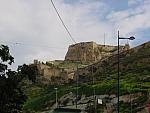 Castle of Santa Barbara
Castle of Santa Barbara
Link to the page about the Castillo de Santa Barbara
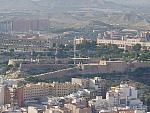 The castle of San Fernando
The castle of San Fernando
The fortress, builded in consequence of the fight with french troops in Spain in the 19.century, has to show today only some walls, a yard and a gate. In front of it on the mountain Tossal is a small park, in which sometimes meetings or concerts take place. Worth seeing however is the view over Alicante with the castle of Santa Barbara, the port, the bullring, the city hall and the surrounding countryside. A large free parking lot is available underneath the CdT-building.
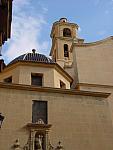 The Concathedral of San Nicolas de Bari
The Concathedral of San Nicolas de Bari
This church build in the Renaissance and baroque style over the remainders of a mosque, is from the outside rather simply and inconspicuously, shows however on the inside with its 45 meters high dome stately extents. It contains a coming union chapel worth seeing and the chapel sank Nicolas, dedicated the saint of the city, both in the style of the Spanish baroque delighted. The art treasures existing in the cathedral are also worth seeing, like the painting named Ánimas (the souls) from Nicolas Borras, the Christ of the good death of Nicolas de Bussi and a canopy from marble and jaspis. The cathedral at the Plaza Canonigo Penalba is open at time of services.
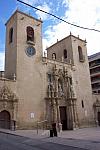 The church of Santa Maria
The church of Santa Maria
On remainders of a moors mosque in the 16. Century in the gothical style completed, the oldest church in the city of Alicante, which had again to be developed after a fire 1484 with a baroque front, contains a main altar in the Rococo style, the chapel del Bautismo, the coming union chapel and the chapel of the unsullied conception. Worth mentioning also the large baptismal font from marble of Carrara, the gothical stone sculpture Saint Mary and Saint John. The church is at the Plaza de Santa María and is opened to the time of the fair.
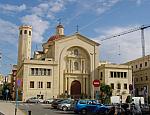 The church of Nuestra Señora de Gracia
The church of Nuestra Señora de Gracia
A contemporary and elegant church at the Plaza de la Montañeta completed in the year 1951.
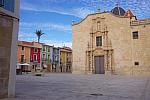 The convent of Santa Faz
The convent of Santa Faz
This outside of the city lying convent in the village Santa Faz, accommodates a Reliquie with the flax cloth, with which the holy Veronika is to have dabbed the face of Jesus on his suffering way, to which each year walks a large quantity of pilgrims from Alicante and the environment, traditionally on the second thursday after Easter. Here also two large sons of the city are buried, the composer OSCAR ESPLA and the painter and sculptor EUSEBIO SEMPERE. The convent is a typical fortress-like building with a large tower, remarkable from the outside. The monastery is attainable over the Carretera Alicante Valencia (N-332), departure Santa Faz.
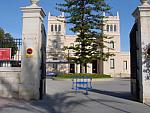 The archaeological museum of the province - MARQ
The archaeological museum of the province - MARQ
This museum offers an interactive journey in the time with its different exhibitions, begining with prehistoric pieces over the epoch of the Iberer, to the Romans, in the Middle Ages and the modern times. Likewise one gets view on the work of the archaeologists whether with excavations in caves or with the underwater archaeology. Belonged to the museum also the excavation place of the ancient Lucentum in Albufereta and there is a combination ticket for the attendance of the museum and Lucentums. The MARQ at the Plaza Gómez Ulla is opened from Tuesday until Sunday.
On the homepage www.marqalicante.com of the museum are further informations in spanish or english callable.
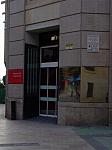
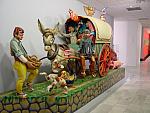 The museum about the bonfires of Sant John
The museum about the bonfires of Sant John
The Hogueras de San Juan in Alicante are committed each year with much fireworks and the burning of gigantic figures made from wood and paper, which most have a caricatural background. These figures and the models of the price-crowned Fallas, called Ninots, are issued in this museum. Posters, designs, photographies, flags and other exhibits draw an exact picture of this long tradition. The exhibition is in the Casa de las Fiestas in the Rambla Méndez Núñez, is closed on Mondays and the entrance is free.
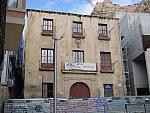 The museum for contemporary art - MACA
The museum for contemporary art - MACA
The Museo de Arte Contemporáneo de Alicante (MACA) in the Casa de la Asegurada build in the baroque style and in former times used as granary, city hall and prison, is one of the oldest buildings in town. This complex contains the urban art collection with works of the 20. century with pieces of Miró, Dalí, Max Ernst, Picasso, Rauschenberg and the collections Eusebio Sempere and Juana Francés, two artist from Alicante, who bequeathed their works to the city. The museum is at the Plaza de Santa Maria, 3 in the quarter of Santa Cruz.
The museum is closed until 2008 because the works on the new building.
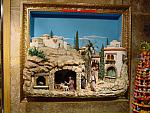 The crib museum
The crib museum
An exhibition of Christmas scenes about the birth and the life of Jesus, made from artists of the cribbuilders of Alicante. The museum is in the Calle San Agustin 3 and on Saturday noon, Sundays and on Mondays closed. The entrance is free.
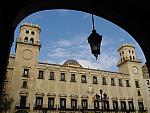 The town hall of Alicante
The town hall of Alicante
The city hall (Ayuntamiento) of Alicante, made in the baroque style, was completed after construction period of nine years 1710 and the Fasade limited by two towers offers to the viewer twelve wrought-iron balconies in the first stick, the main entrance framed by two double columns and the city-arms made rom white marble, present over it. In the building a collection of paintings can be visited, which contains among other things the portrait of the unsullied conception created by Lucas Espinoso. A memorial stone is remarkable in the first stair made from white marble. A further characteristic is a sign, which specifies the geographical zero point, after which the levellings in completely Spain are aligned. The city hall at the Plaza de la Ayuntamiento 1 is opened under the week daily and the entrance is free.
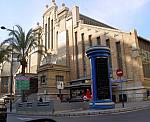 The central market
The central market
Built between 1911 and 1912 on pieces of the old town-wall of Alicante the central market is worth visiting. It is the first address for the purchase of fresh fish, meat, fruit and vegetable or just for watch the busy driving. The market is in the Avenida Alfonso XII el Sabio, 1 and from Monday to Saturday opened in the morning.
The bull-ring
One of the oldest still used bull-fight arenas in Spain. Build 1849, reconditioned and extend 1888. In the arena there is a bull-fight museum, in which bull heads, sculptures and bull combat clothing is issued. The entrance into the museum at the Plaza de España is free and it is opened Tuesday to Saturday.
The port
The economical mainspring of the city of Alicante, mentioned 1271 for the first time in documents and important by the commercial route to America beginning here and the good tying up at the railway and freeways. Today there is a yachting port worth seeing and from here goes a ferry to Oran/Marokko and Ibiza. The port of Alicante is today also one of the most important nightlife district of the city, with restaurants, bars, discotheques and cinemas.
The old town
The Barrio, worth seeing angle width unit borough, which with its small lanes, many fashion shops, restaurants and bars is good for strolling and staying.
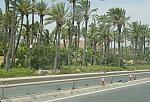 The park El Palmeral
The park El Palmeral
One of the most beautiful parks of Alicante, at the Avenida de Elche direction airport, coming out from a large palm garden, is always worth a visit. Here are walking ways, children's playgrounds for all age groups, boats, picknick tables and a beautiful view over the bay of Alicante.
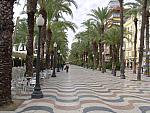 The promenade Esplanada de España
The promenade Esplanada de España
Consisting of 6.5 million marble tiles, one of the most beautiful promenades of Spain and the meeting place for the people of Alicante, which listen there to the frequently taking place concerts. At its side there are restaurants and bars with kitchen for each taste, from the traditional Spanish tapas over fast-food and kebab up to exotic specialities.
Objects of interest in the surrounding of Alicante
Guadalest - the mountain village
One says, this village is one of the most visited tourist attractions of Spain, which is to probably due to its unique situation on a mountain. On the top of the place goes only at footway thru a 15 meter tunnel in the rock, which is to be locked by a artful gate which protected the inhabitants in times of war. In the village one can visit the house of the family Osuña, a museum that shows the life-style of a rich family in the 18.century. From there a way leads to the castle and to the highest altitude cemetery of Spain. After the tour one can visit the former prison under the city hall, buy something in one of the numerous shops, eat something in one of the restaurants or simply enjoy the beautiful outlook on the storage lake of Guadalest and the surrounding mountains. The lower part of the village has to offer among other things still some museums for example a miniature museum, a historical and torture museum, a crib and doll's house museum, in order to call only some of them. It pay attention that parking lots in the place are in season goods in short supply and one can be glad, if one must park not all too far away from the village.
There are further informations on the homepage of the city hall Ayuntamiento de Guadalest in spanish, english or french language.
| The mountain | The chuch tower | The lake |
| Look from the castle | The younger part of village | The Guadalest castle |
| The old prison | Castle and cementary |
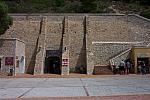 The stalactite cavern of Canelobre
The stalactite cavern of Canelobre
This cave is approx. 25 km away from Alicante, toward Busot in approximately 700 m height on the north side of the mountain Cabeza de Oro and the approaching road is well signed, for spanish conditions. In the cave one finds different stalactits in different forms and in the summer time, due to the good atmosphere and acoustics of the cave, music meetings are presented to the visitor. It is remarkable that the cave in the Spanish civil war served as ammunition storage and workshop for aircraft engines. In this time also the tunnel of entrance, 45 m long, was developed.
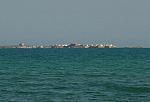 The island of Tabarca
The island of Tabarca
Once the starting point for the Berber-pirates, armed at the end of the 18.century by king Charles III. with a fortress town and setteled with italian fishermen, which were held imprisoned on the african island Tabarka by the Algerian king and who gave their island then also the name Nueva Tabarca. Worth seeing are the city attachments with their different gates and fortifications, the military church Iglesia de San Pedro y San Pablo, the house of the governor, the cove Cueva del Llop Marí with entrance from the seaside and the Torre de San José, a 27 m high, single standing tower, planed in the 14.century. In the year 1986 the area around the island was explained as the first sea protection area of Spain, i.e. underwater hunting, any sort of watersports and the withdrawal of animals and plants is strictly forbidden. Tabarca is reachable by boats from the port of Alicante or from Santa Pola.
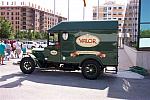 The chocolate museum in Villajoyosa
The chocolate museum in Villajoyosa
IIn this museum, in a 19.century building, one can follow the history of the chocolate, their processing and the history of the company Valor in different rooms.There are machines, tools and documents over the origin of the chocolate, its processing relating to crafts and the industrial production. The museum is daily opened, except Sunday, and the entrance is free.
Further information is available on the homepage of the company Valor in spanish and english.
The museum of turron in Jijona
The Museo del Turrón in the industrial area Ciudad del Turrón in Jijona shows the production and the merchandising of the well known Turrón de Jijona. The museum is divided in three floors, that treat one theme. The third floor is about the ingredients of the Turrón, the second floor about the production of the Turrón and the first floor about the merchandising and the selling. Here is a store, too. To the visit of the museum belongs a look in the modern turrón production in the fabric rooms. The museum is opened daily from 10 a.m., closes monday to friday at 7 p.m., saturdays, sunday and holydays at 1 p.m.
More informations you will find at museodelturron.com in english, spanish and german language.
Recreation parks
About the themeparks at the Costa Blanca Informations are here
Further texts and photos will follow
I am always grateful for suggestions and references, please send me a E-Mail to Feedback
